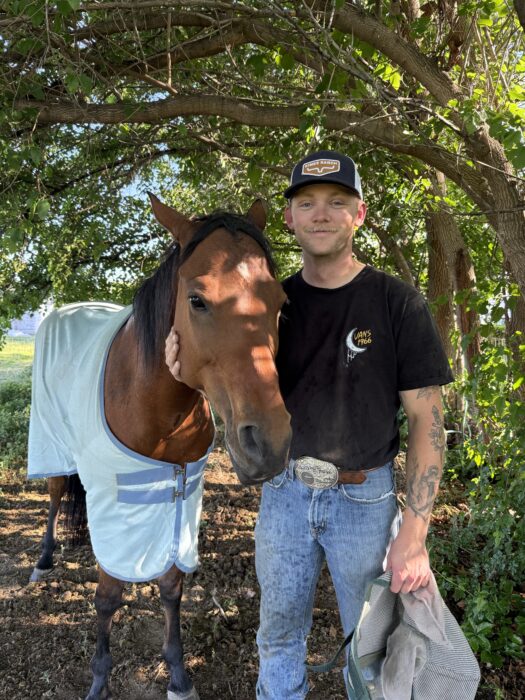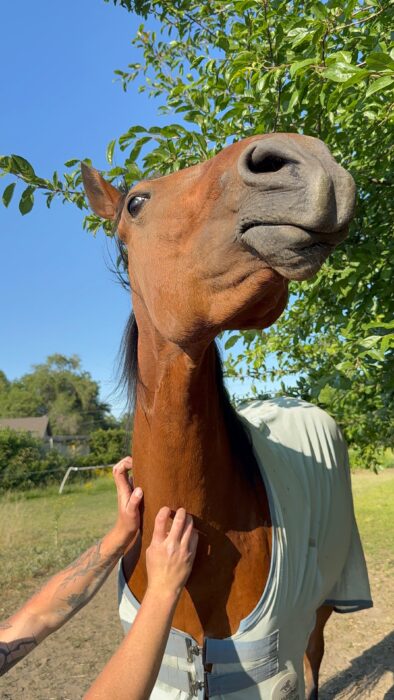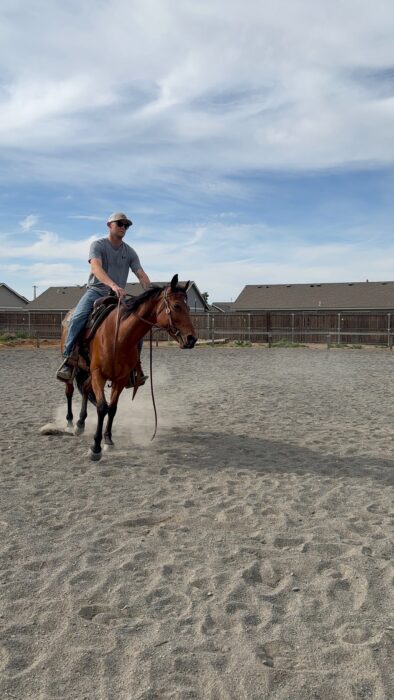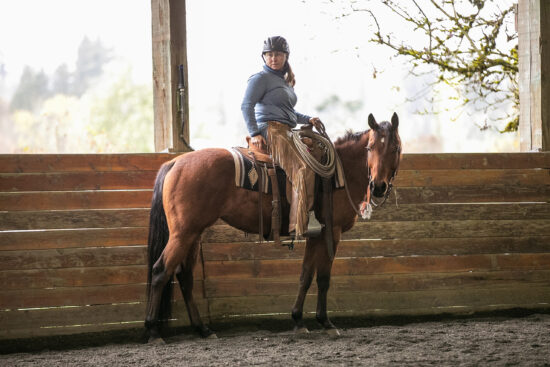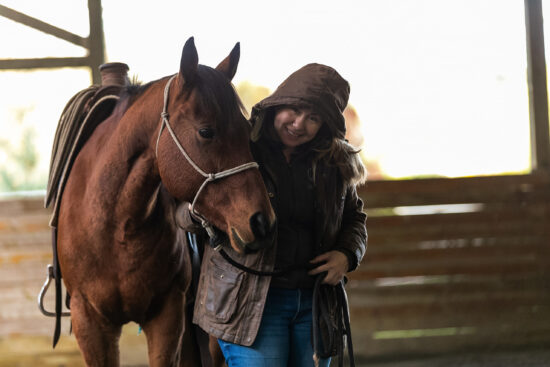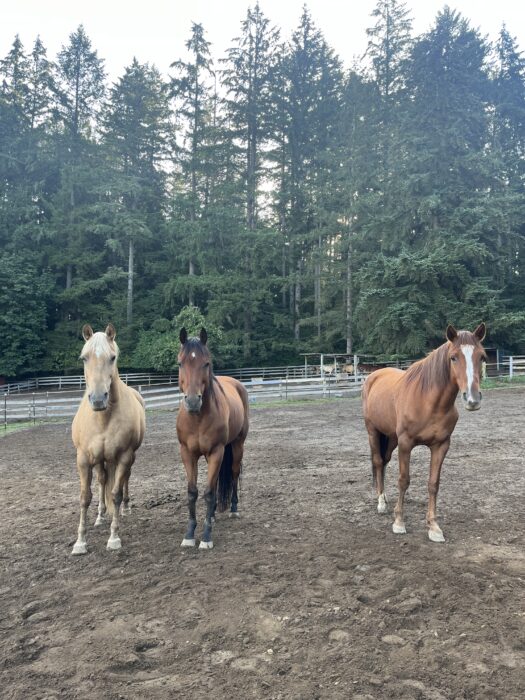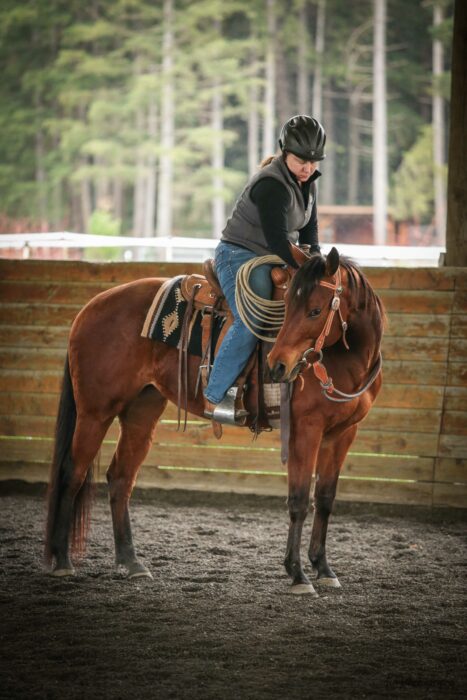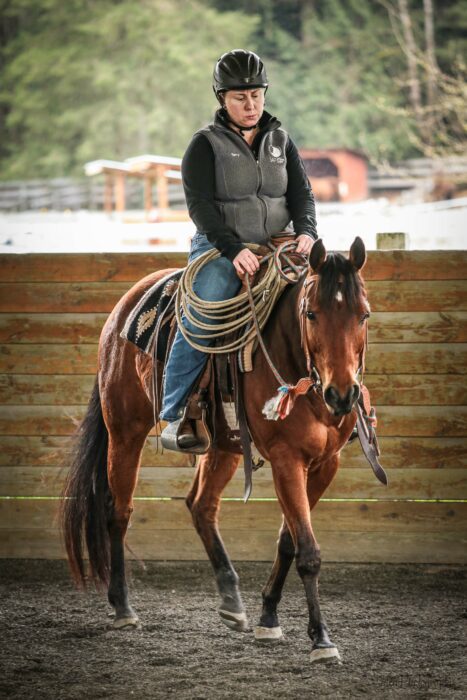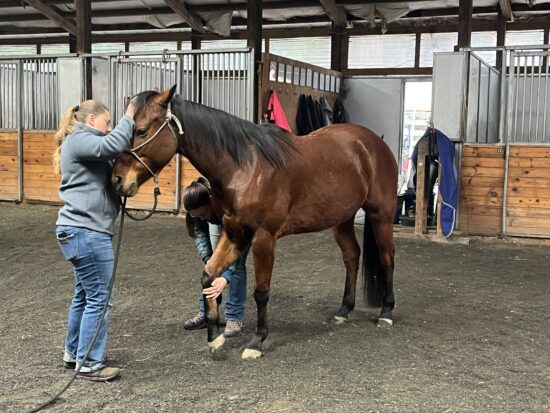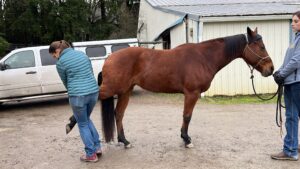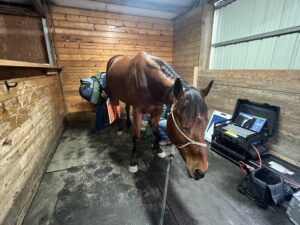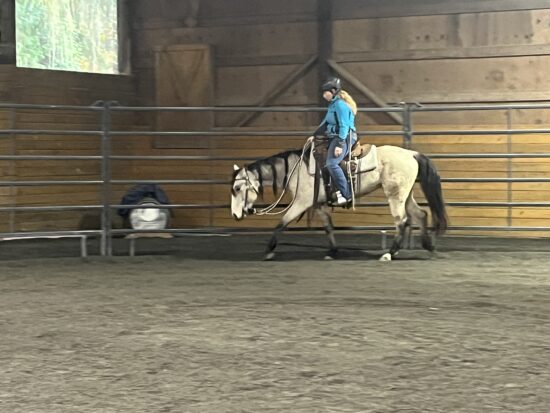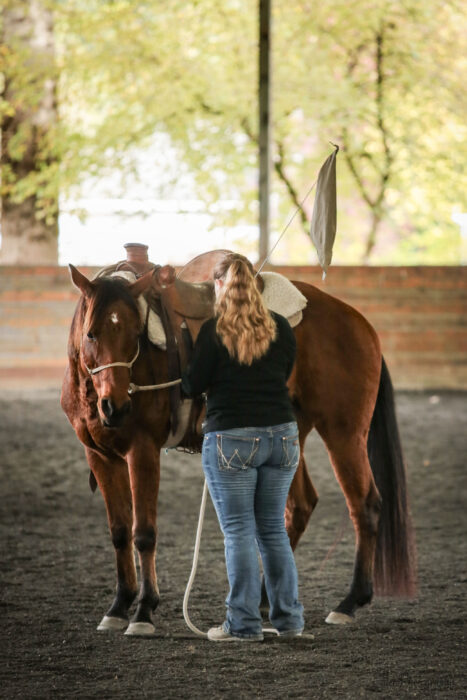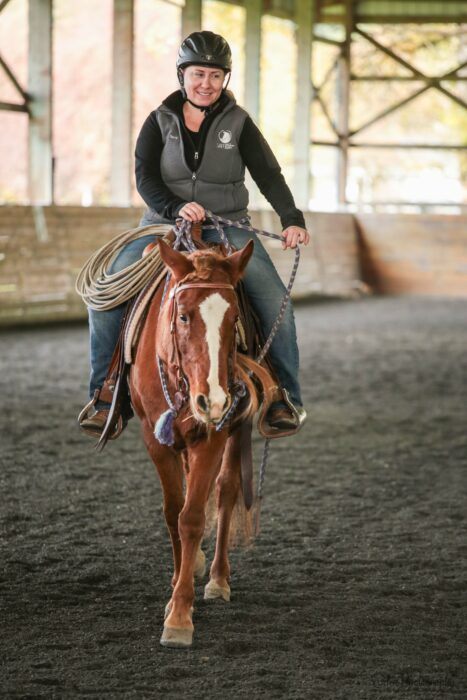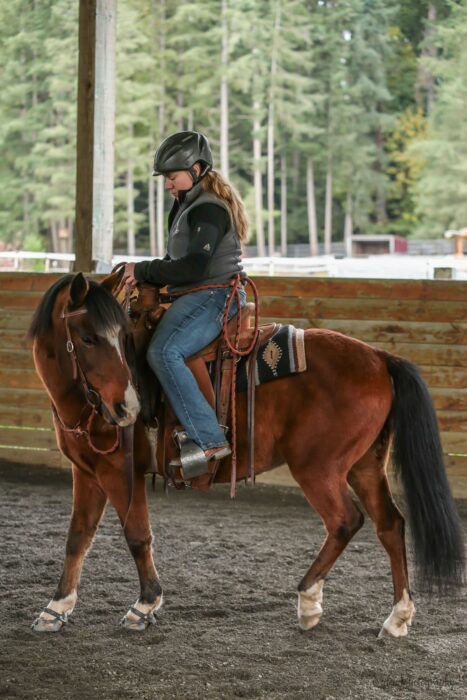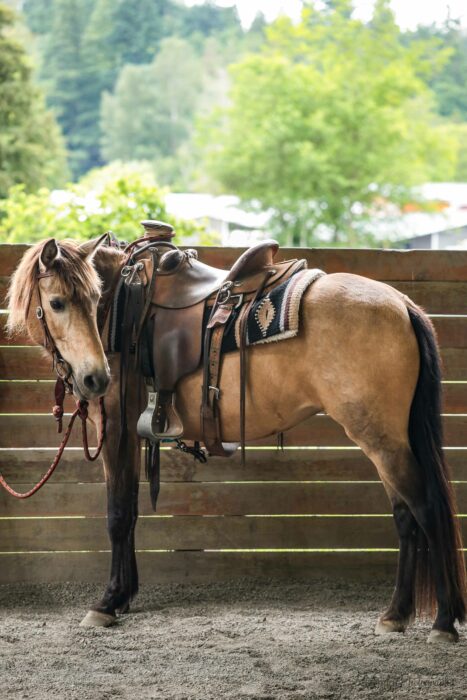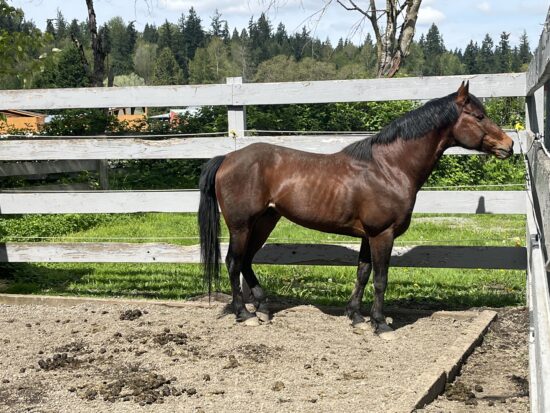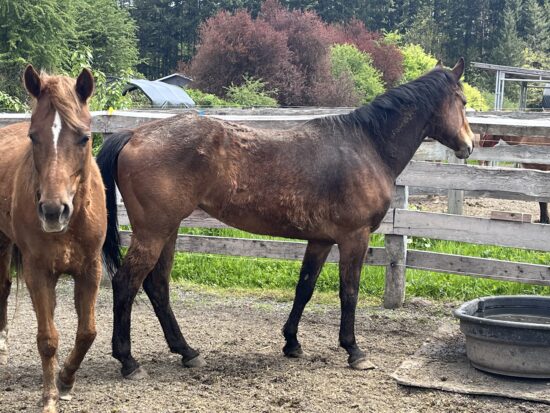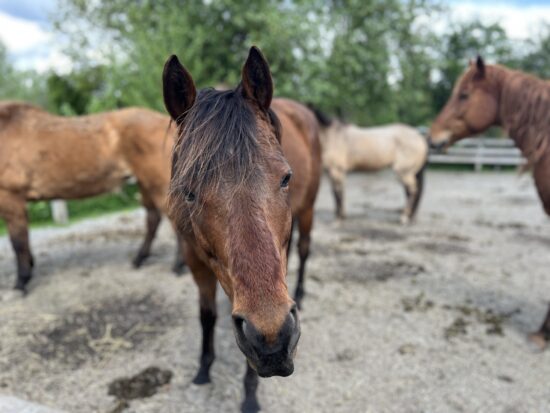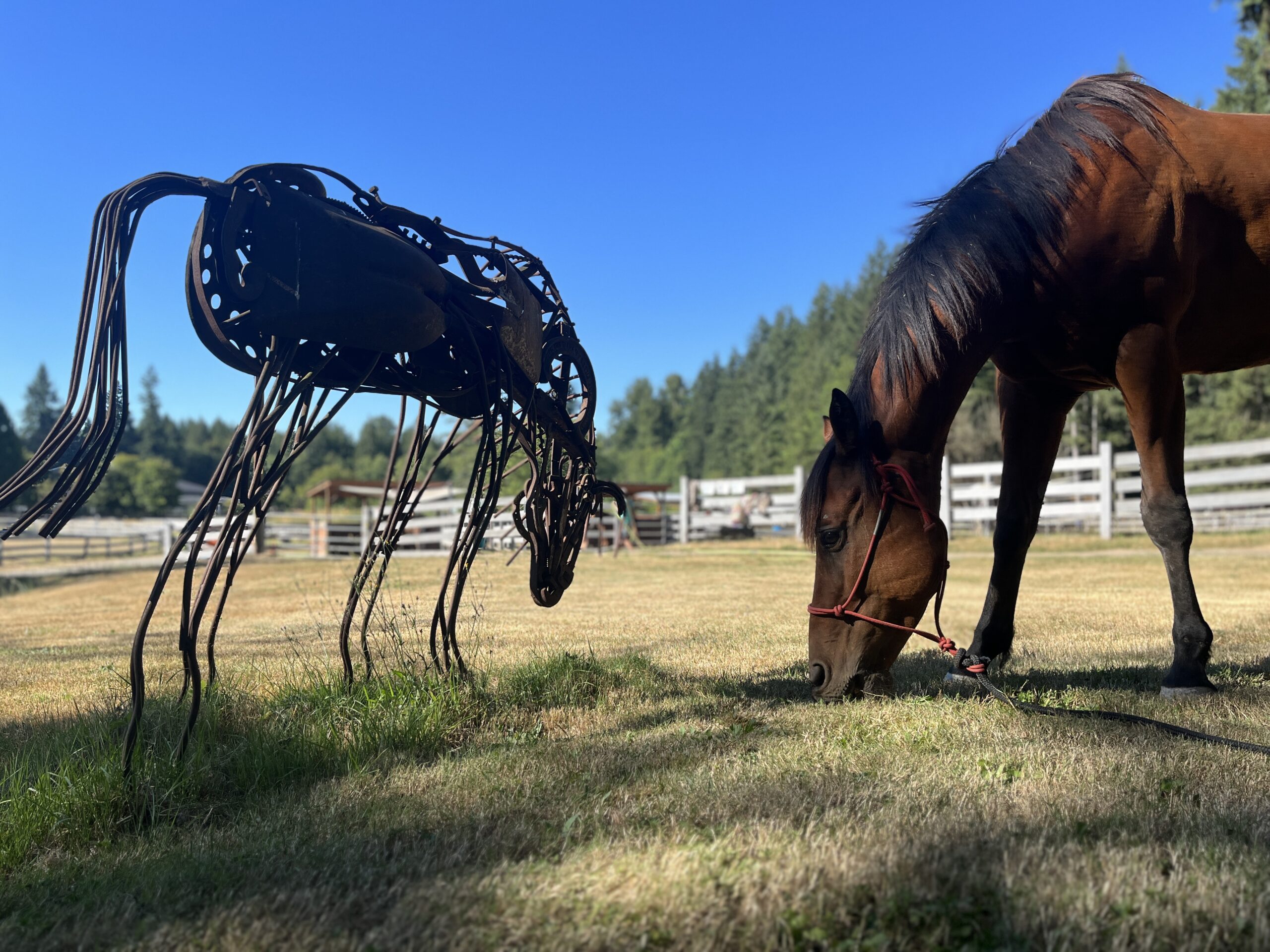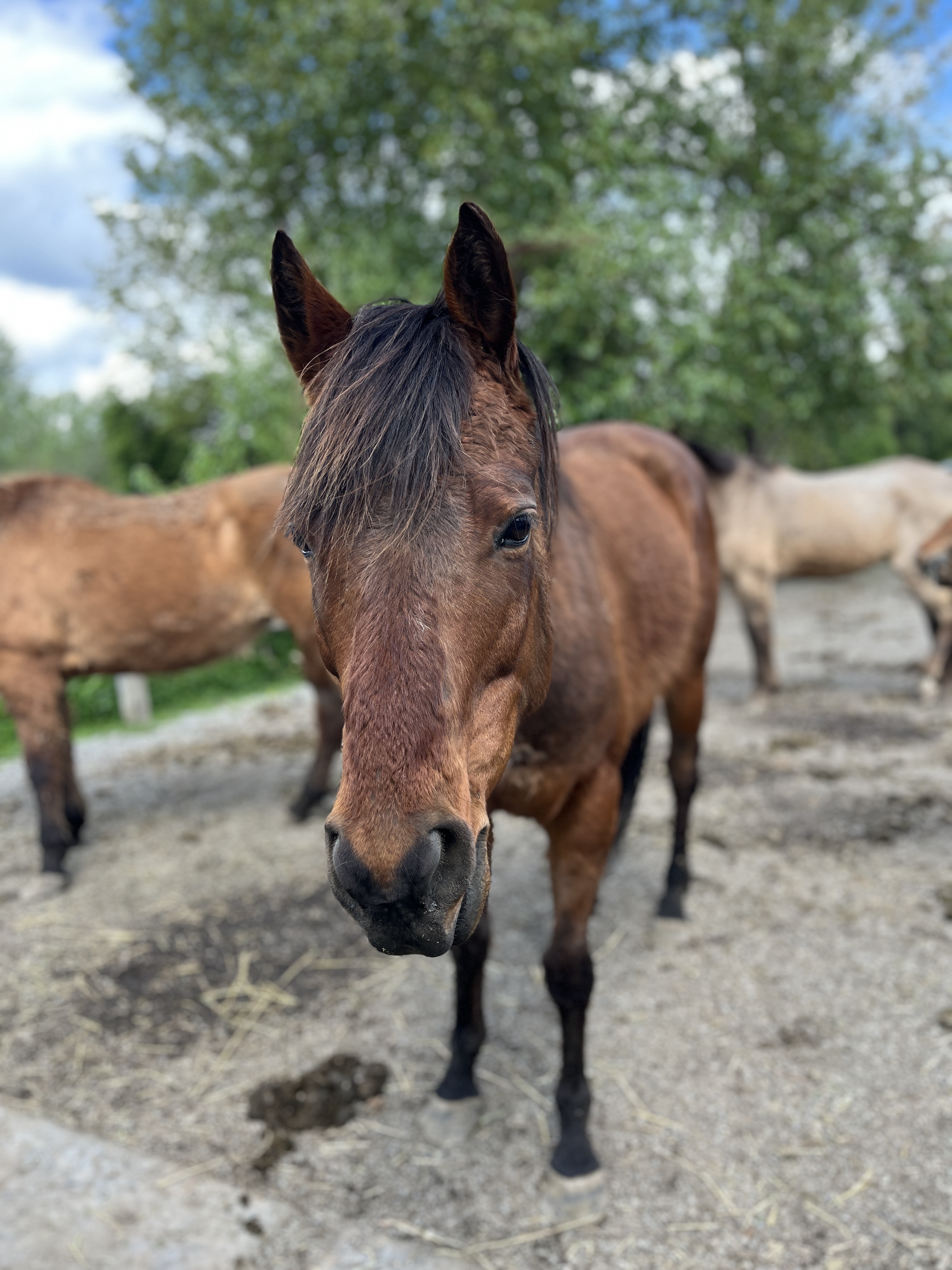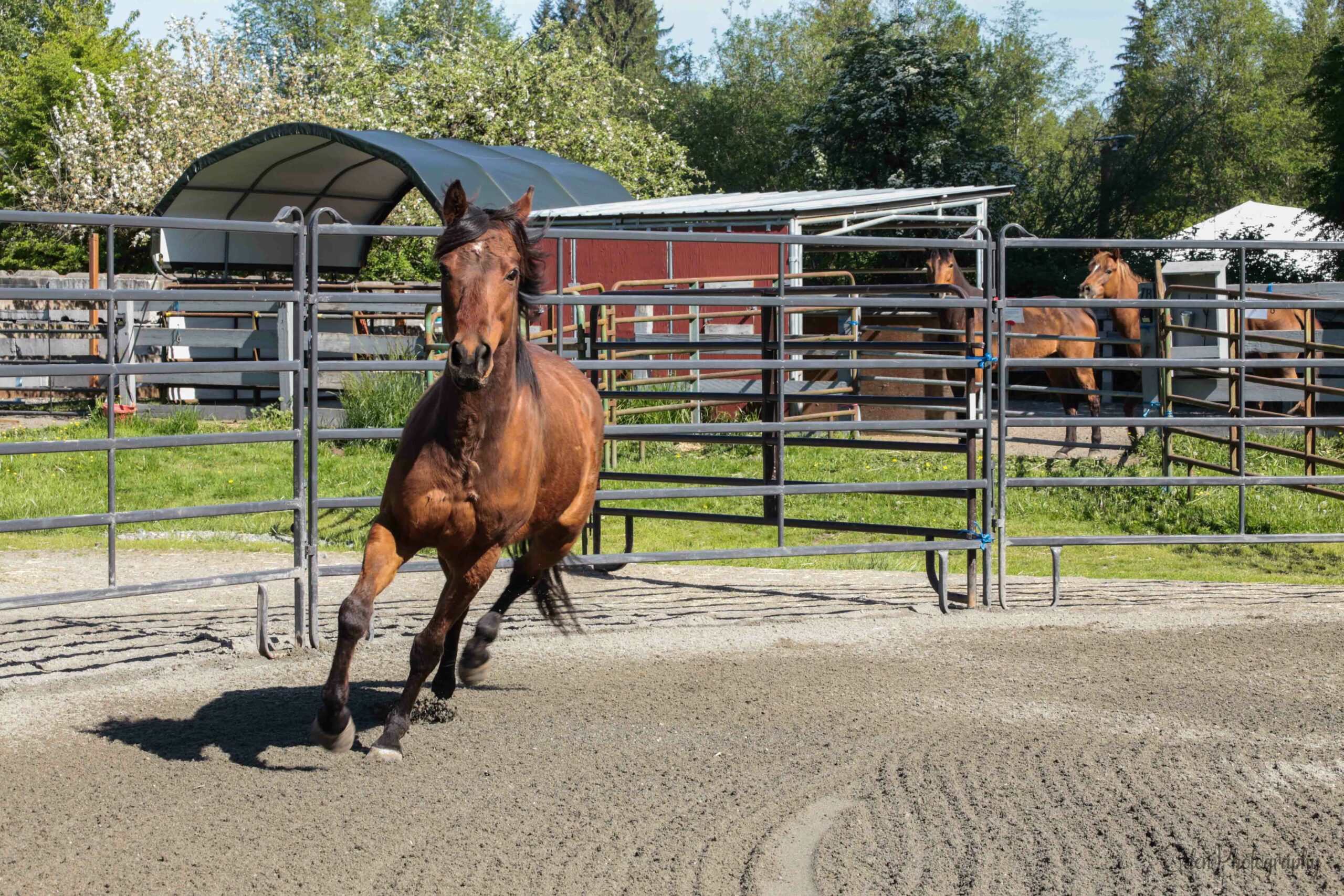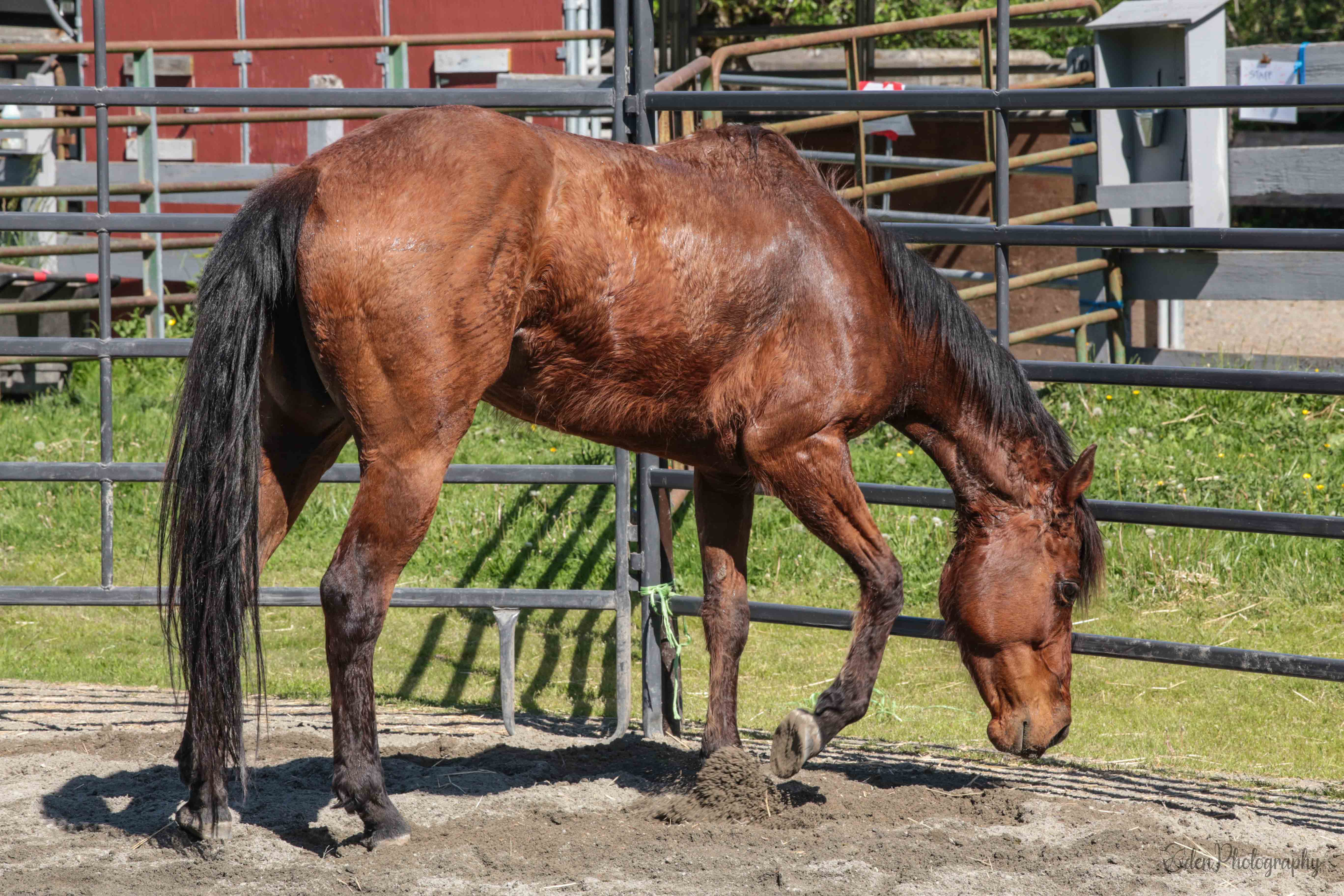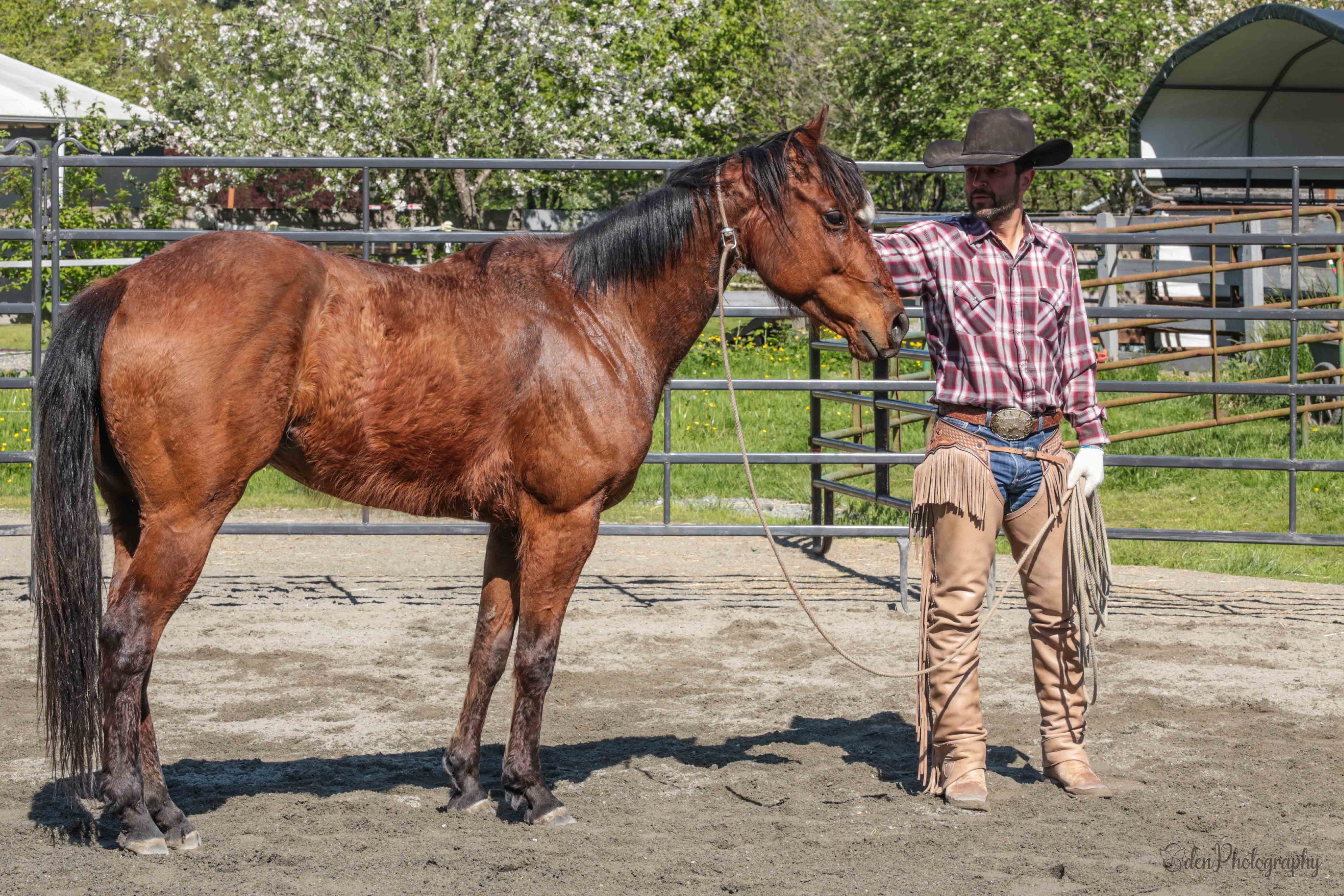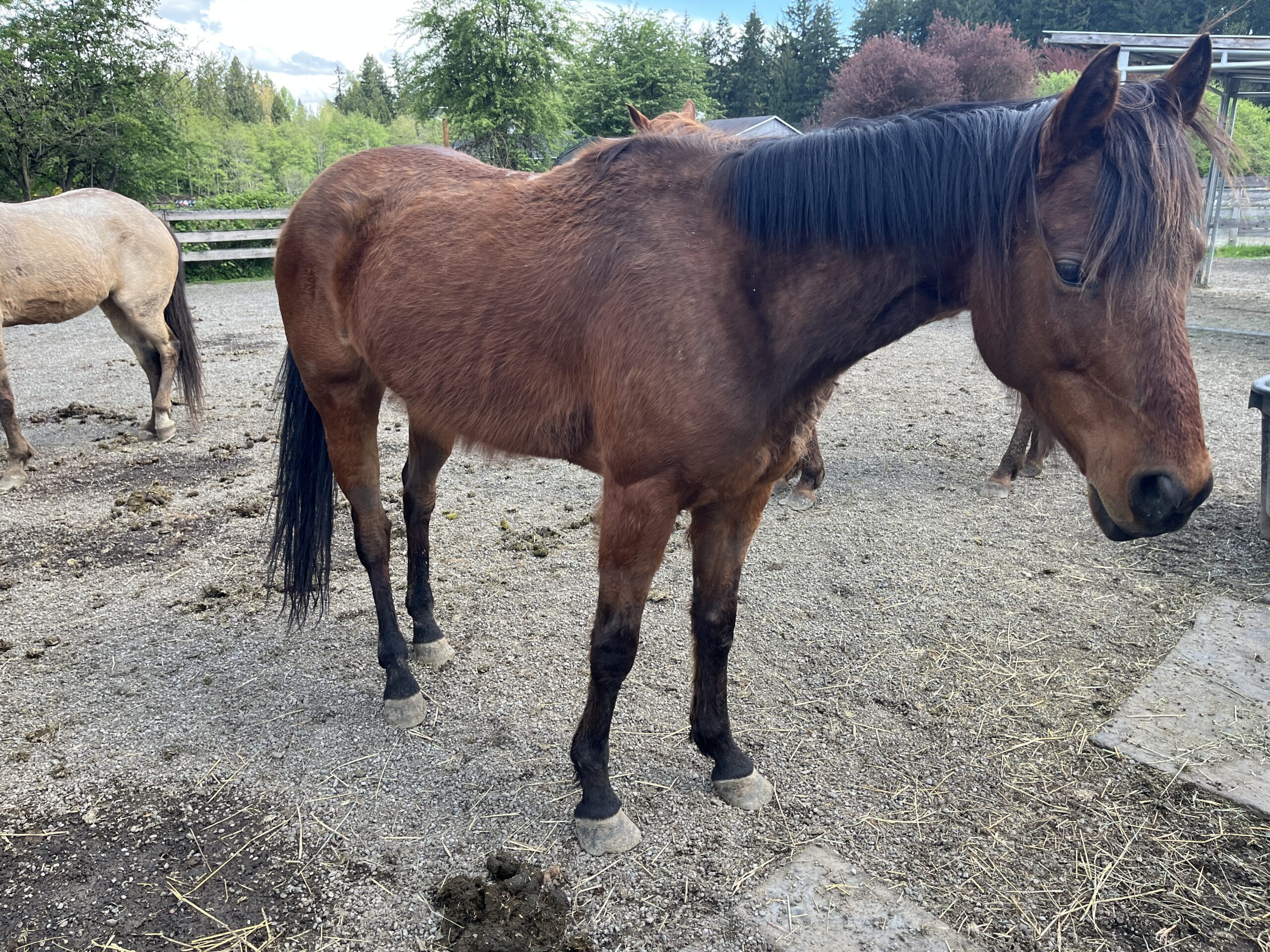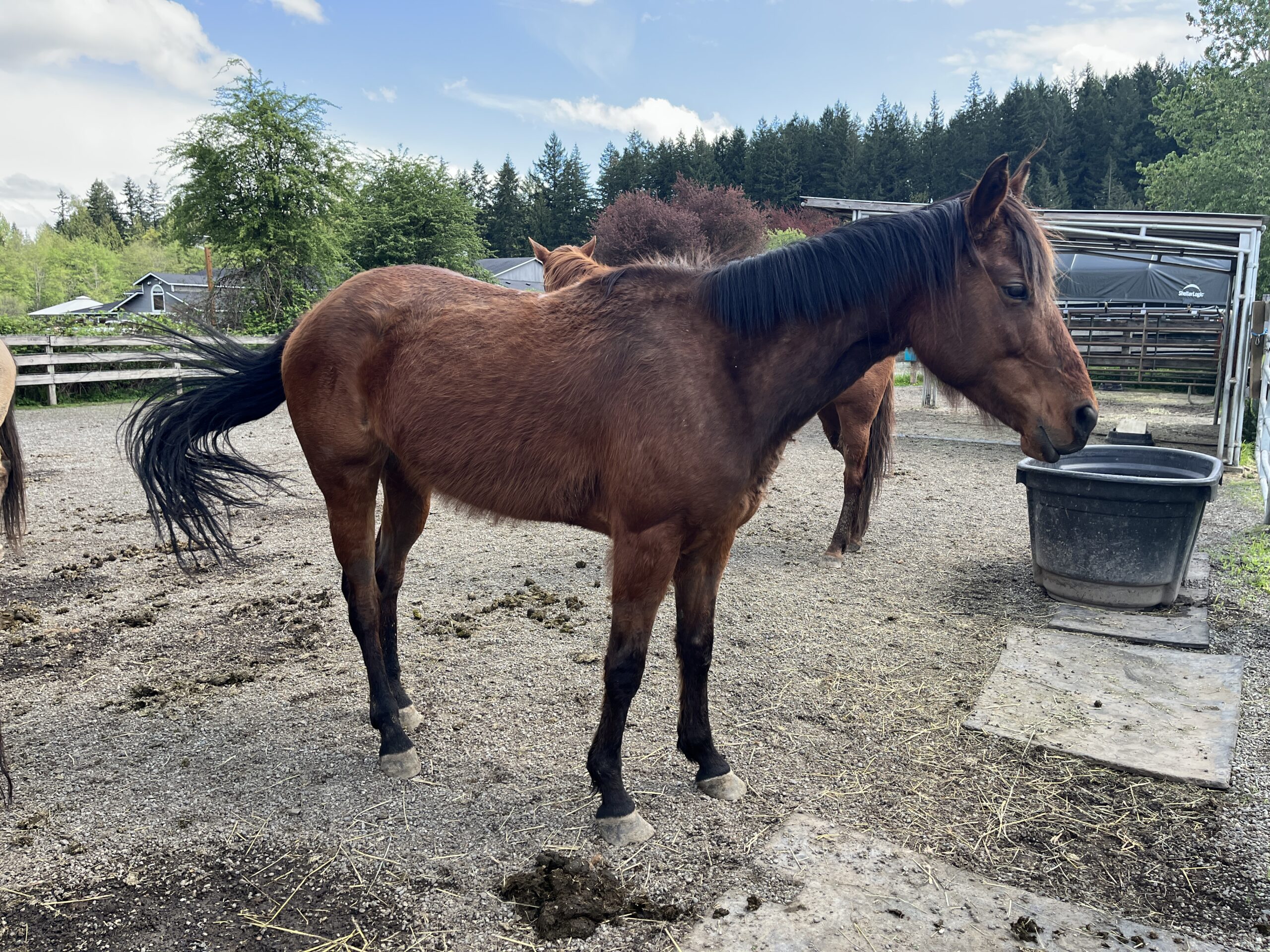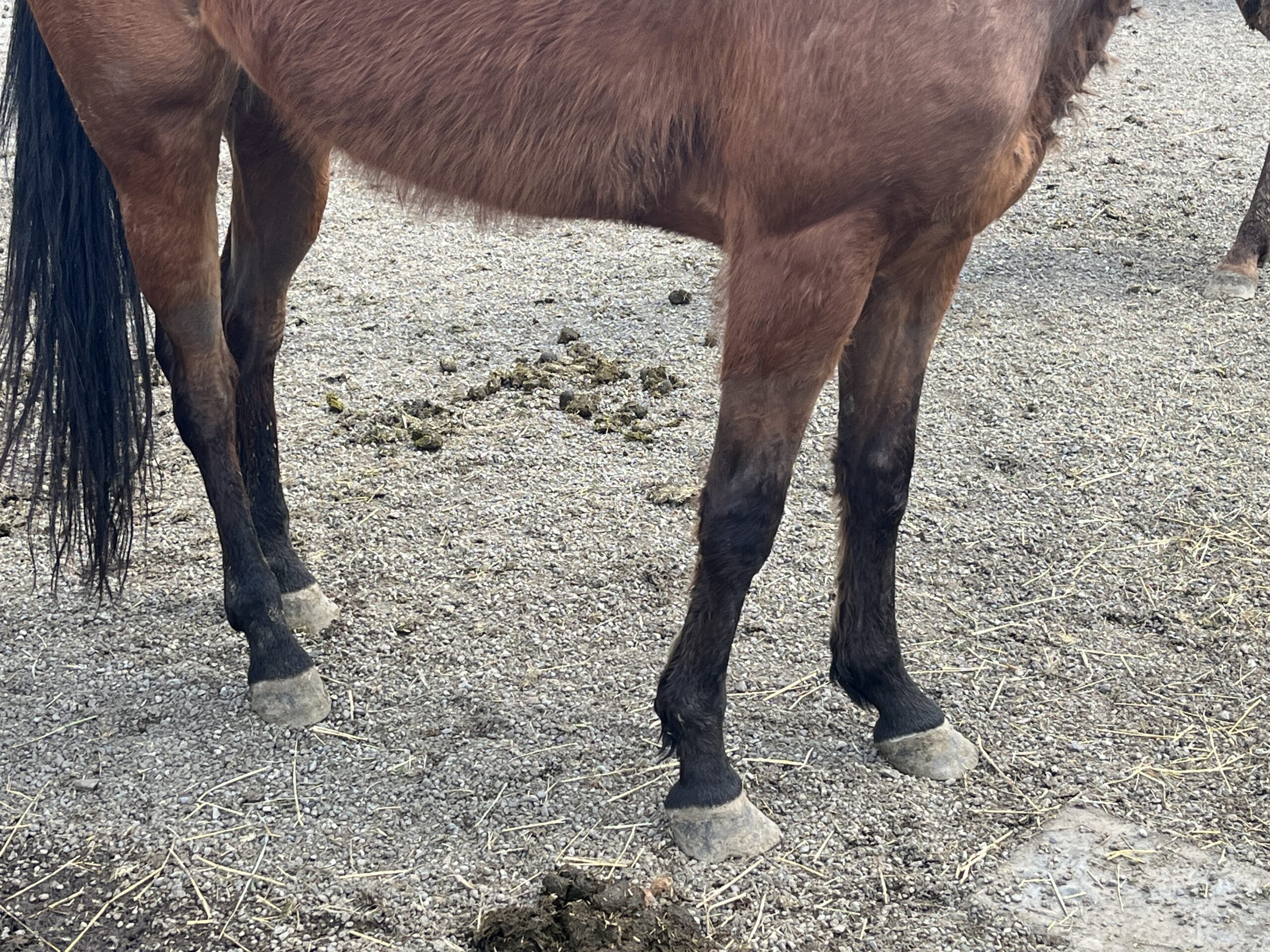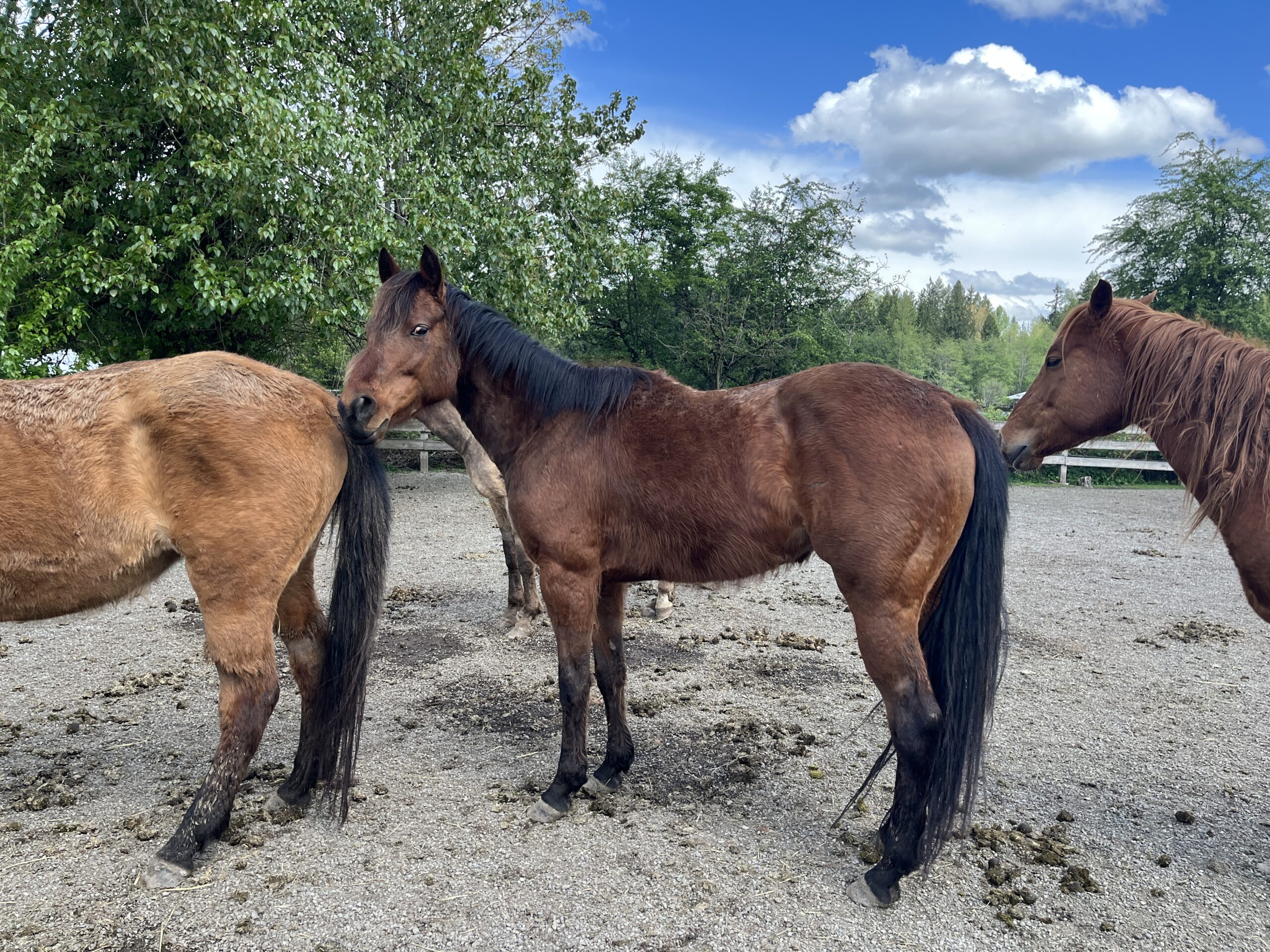Wren
2008 Quarter Horse mare
Type of Rescue: Owner Surrender
Intake Date: 5/6/2023
Adoption Date: 5/3/2025
Length of Time with SAFE: 2 years
ADOPTED!! by Jake
Wren came to SAFE in May of 2023 as part of a 7 horse owner surrender situation in the Gig Harbor area. She, along with her 6 herd mates, were living in poor conditions, surrounded by broken panels, standing in deep mud, without clean water.
While she arrived a bit nervous and at least mostly unhandled, it was not long before she was learning the ropes. She is a fast learner, and was quick to prove how brave she is to new experiences, like seeing the farrier and leaving her friends for a walk around the property.
After a period of foundational groundwork, Wren was started under saddle as a riding horse, where she learned quickly and grew into a solid partner under saddle. In April of 2025, Jake and his fiance came out to meet horses at SAFE and fell in love with Wren’s sweet personality and willingness under saddle. In early May, they took her home. Wren, now named Sage, has found her family!
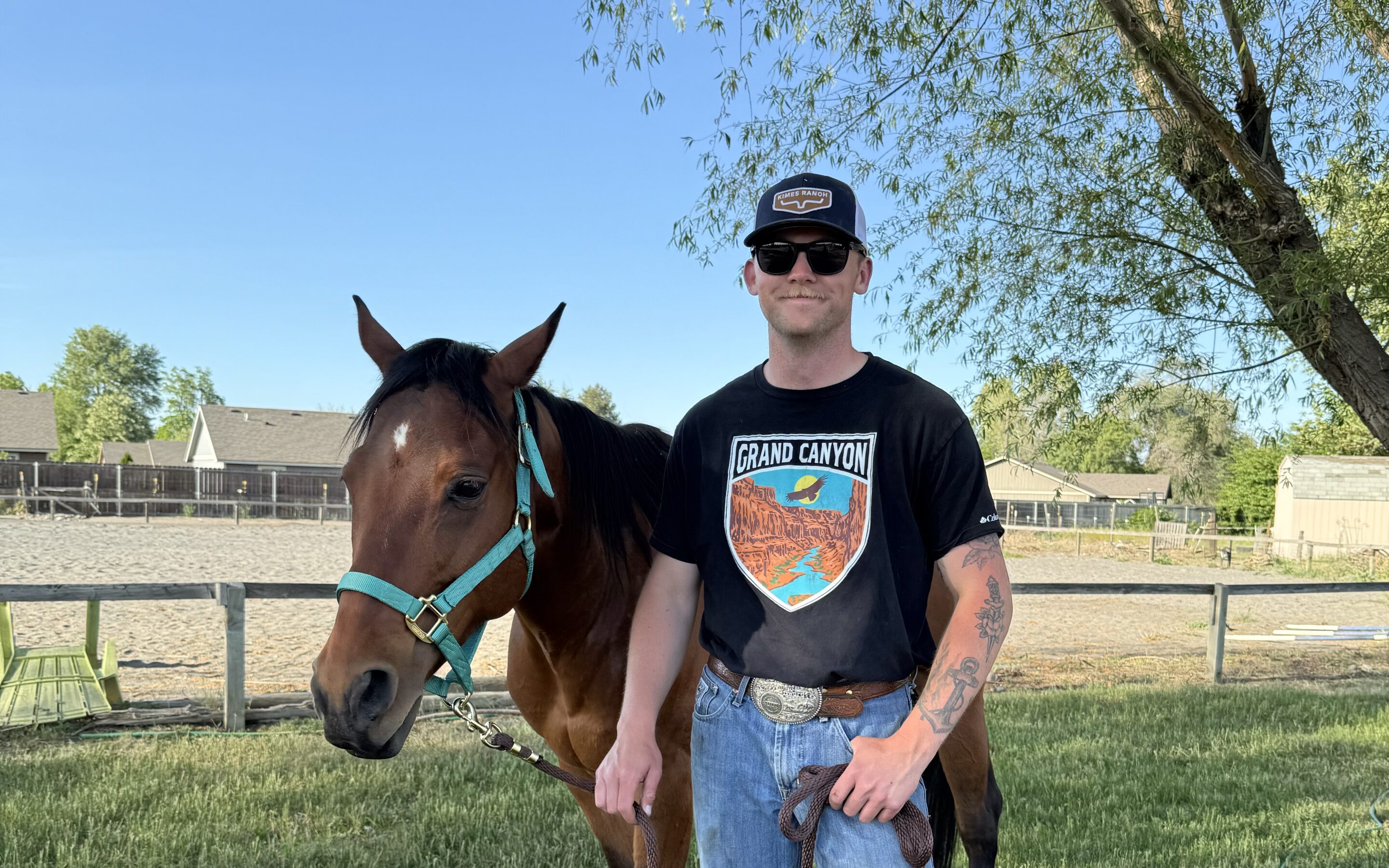
Wren is Adopted!
We are delighted to announce that Wren has been adopted! Jake and his fiance came out to meet some horses, and fell in love with Wren. For the last month or so, Wren, now called Sage, has been settling into her new home, and is now officially a permanent member of Jake’s family! Here is what Jake has to say about her:
“Sage has become so special to us in such a short period of time. She adjusted to her new home very easily and quickly started showing us her personality. She is a big snacker and loves any sort of treat she can find. Sage always trots over to greet us anytime we walk over to her pasture. My fiancé and I love to spend time out in her pasture giving her lots of scratches and love. Sage is a quick learner and has already picked up on a lot. We haven’t had the chance to bring her out on the trails yet, but my fiancé and I have both been able to ride her around the arena and she does amazing for both of us. We introduced her to my mare, Goose, and they seemed to really like each other. Sage has such a sweet personality, and we are so excited to have her as part of our family!”
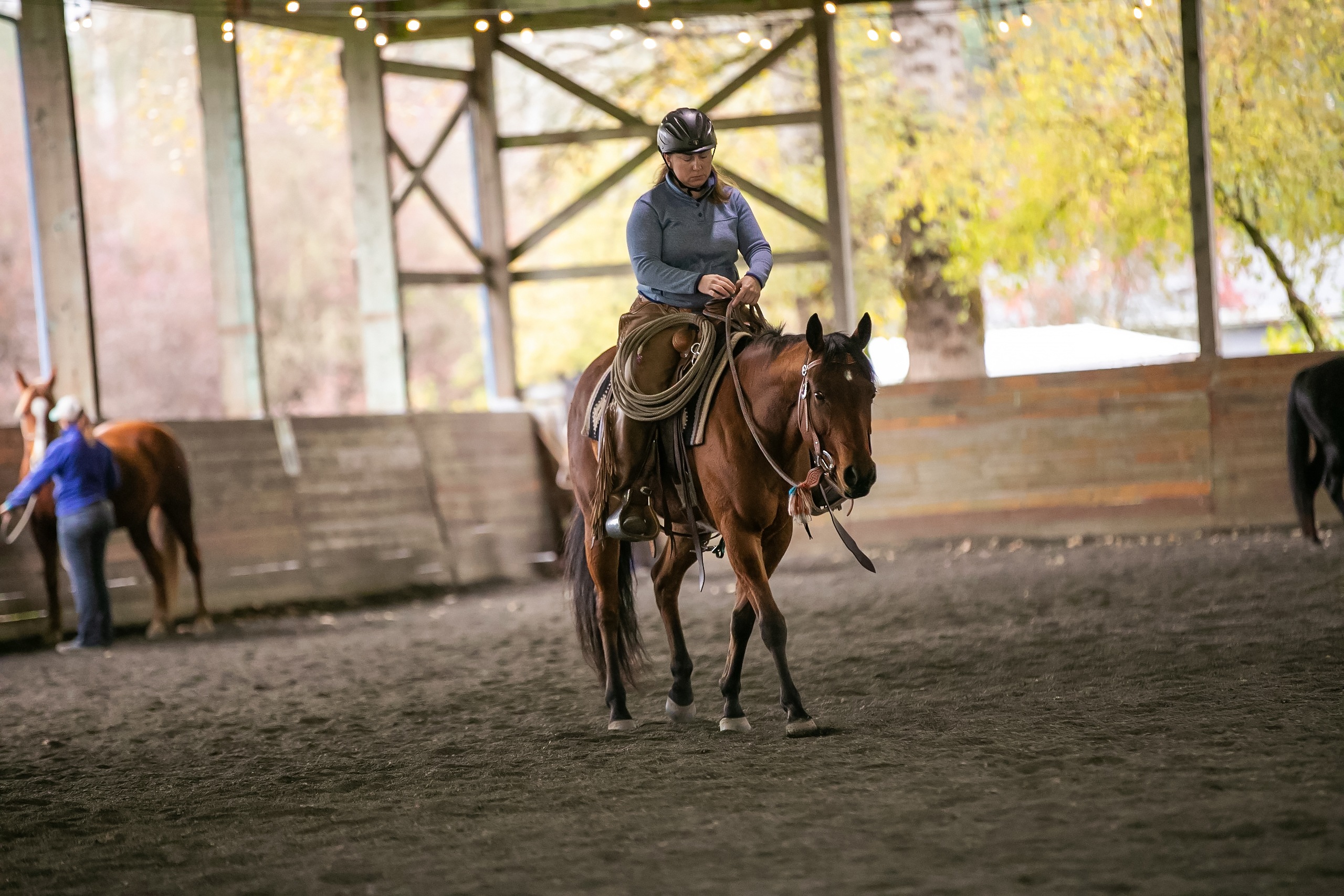
Wren: Building Confidence, Balance, and Trust
Wren has a truly sweet disposition and a heart of gold. She has an incredible amount of try and doesn’t seem to have a mean bone in her body. Gentle with every horse she meets, Wren has proven to be a kind and dependable presence both on the ground and under saddle. She’s shown few faults in her work, and with time and more experience, her “green” traits will naturally smooth out.
Her main challenge has been dealing with tension when the energy around her in the arena rises. Over the summer, it became clear that in new or uncomfortable locations, she would occasionally check out mentally during our rides. We’ve been gradually exposing her to more challenging environments, and while she can still get tense, she’s learning to work through it. In these moments, short serpentines are our best friend—they keep her moving, helping her build confidence and reconnect with her rider.
Adding front shoes has made a big difference in her comfort level. She can still show signs of soreness occasionally, so on those days, we take it easy. Gradually building her strength, topline muscles, and balance has helped her feel and look much sounder. Wren’s future might be as a pleasure ride, but what a pleasure it is! She’s one of the top horses in our herd when it comes to experiencing the difference balance can make in a horse’s gaits.
With just a year of riding experience, Wren has become a lovely, enjoyable ride, and she’s ready to meet the right person. She does, however, need a skilled rider to continue her progress and help her reach her full potential.
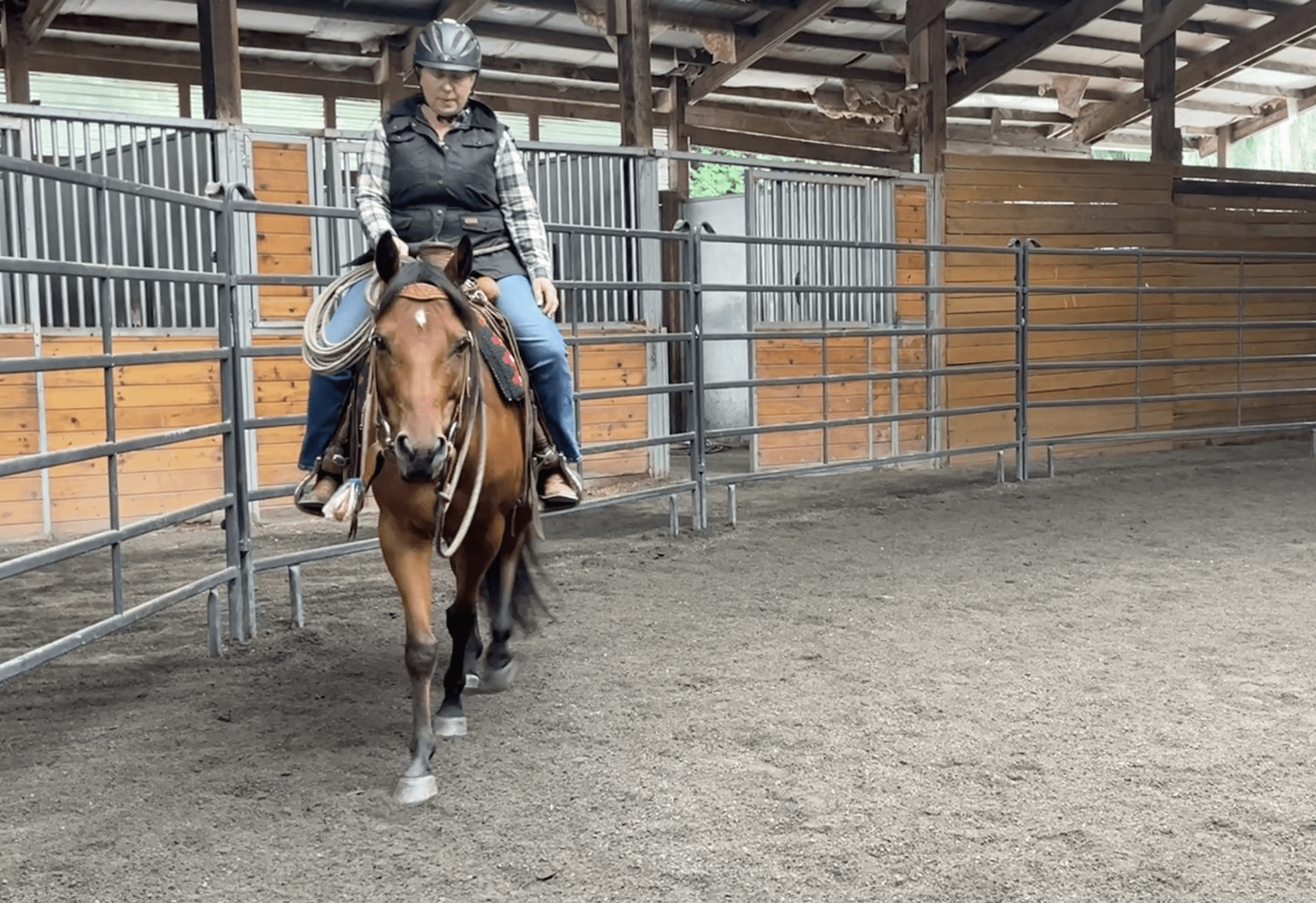
Riding Wren
Wren is nice on the ground and nice under saddle, a great mare all around. Here is a recent clip of her going under saddle — check it out!
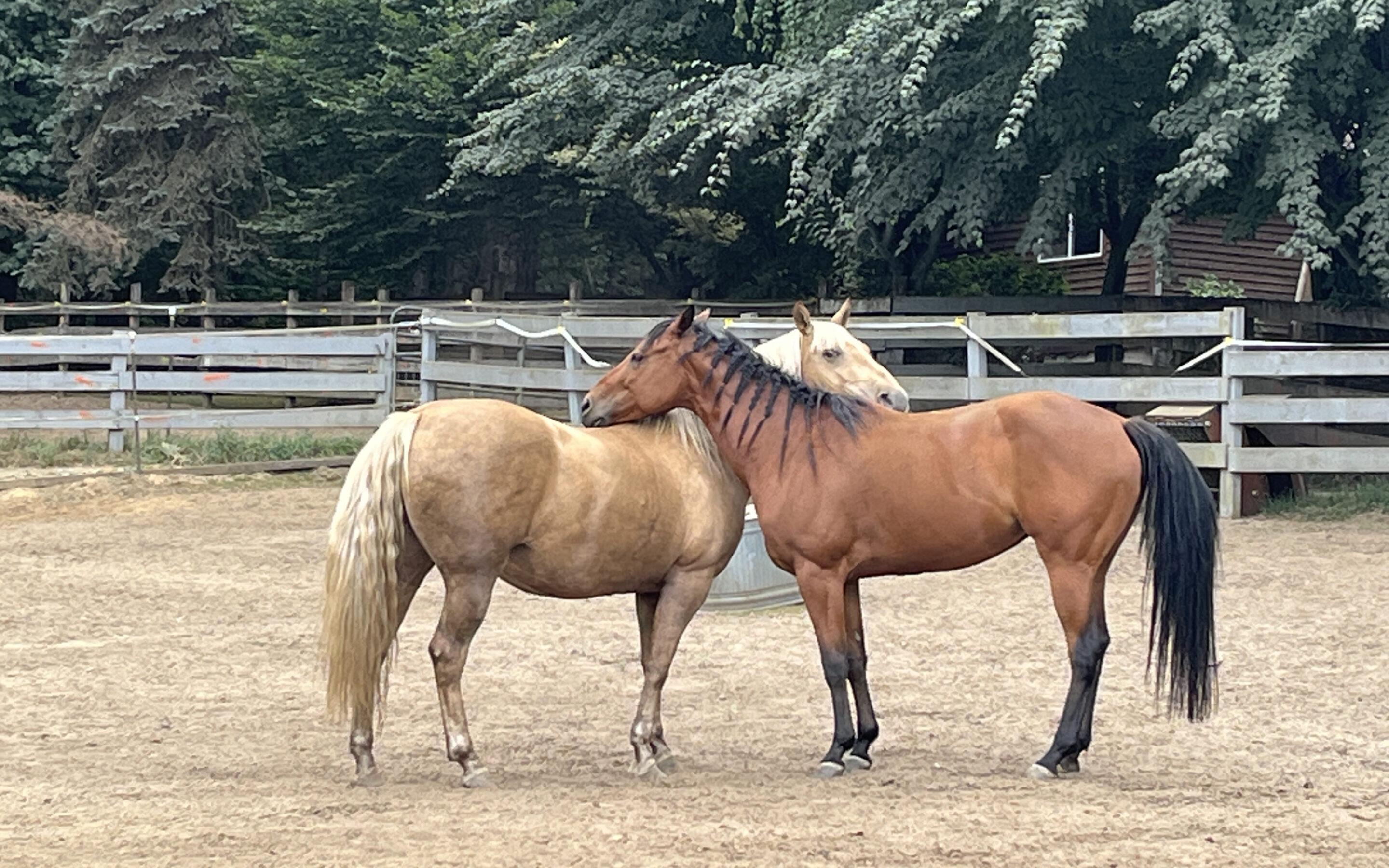
Winter and Wren, Sitting in a Tree
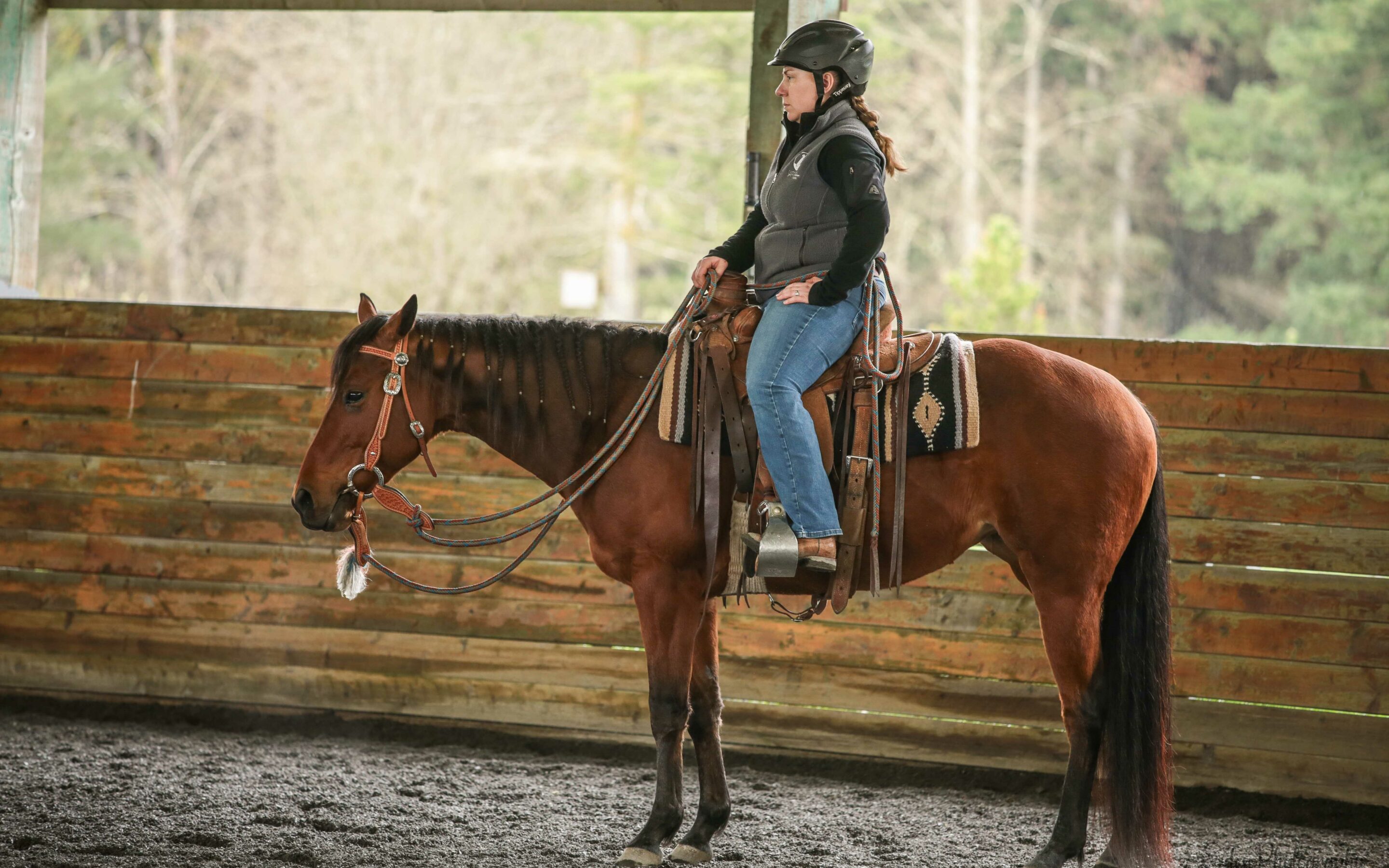
March Joel Conner Clinic Report: Wren
This mare has “try” in spades! One of the sweetest mares on the property, she is eager to meet you at the gate, accepting of everything asked of her and lets out the cutest nickers when you dismount. She LOVE her tummy scratches when you take off the saddle and stretches her nose out to reciprocate mutual grooming. If you haven’t realized it yet, this is a very special mare!
She has felt tremendously better with her front shoes. Wren is consistently picking up her right lead canter when before it was near impossible to strike off on the correct lead. We have transitioned seamlessly to the large arena and she remained connected to her rider in the bigger space. Wren joined the afternoon Horsemanship clinic with Joel Conner last week. She was a bit tight the first day but after warming up she had no issues with the other horses. We did play it safe, being only in the large arena a handful of times. Even when the energy of the other horses rose, she maintained her composure and her rider maintained her attention.
Wren has a big world to still experience but she has proved a very worthy riding partner. She is turned out to be a stunning quarter horse mare and with some new riding muscles she definitely turned heads and had everyone asking “who’s that mare?” She is ready to meet her next dance partner are you the one for her?
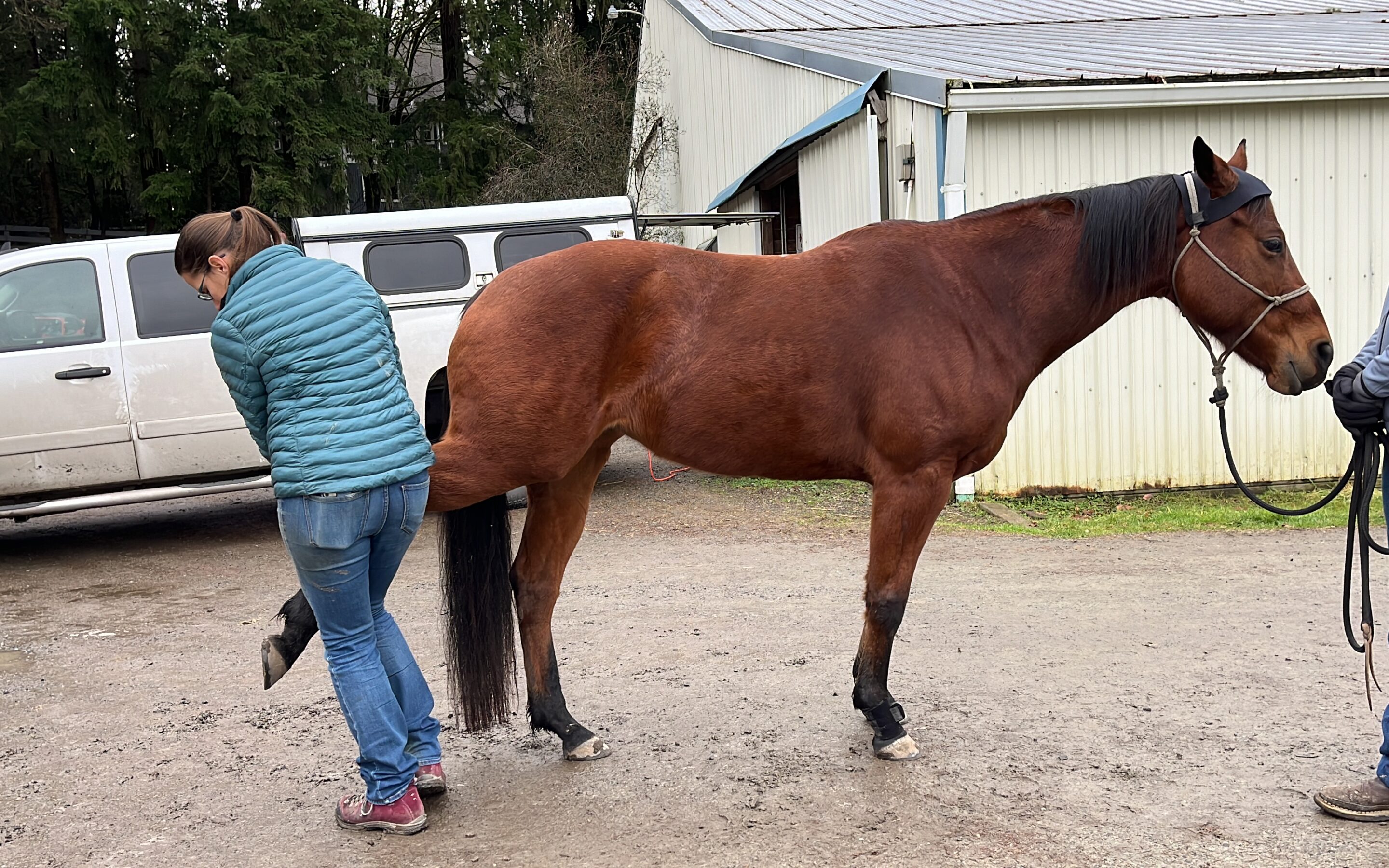
Wren’s Soundness Evaluation
The topography of a horse tells a story, albeit usually one in a language we only partially understand. Each scar, bump, and blemish they arrive with has a history attached. We can draw assumptions, make educated assessments based on professional opinions and our own previous knowledge, but there exists a degree of mystery in even the most straightforward seeming marks. This says nothing of what exists beneath the surface, the ways in which their physiology has been altered by the care — or lack thereof — shown to them in their time before SAFE. Each horse is a puzzle we hope, and try, to decode to the best of our abilities.
We feel it’s important to learn a little more about the soundness of the horses we are riding or planning on riding than those who will live out their days as a companion. A soundness evaluation is a diagnostic tool that helps grant us a baseline of a horse’s movement, and allows us to be more transparent about what their future might look like for an adopter.
We also want to take a moment and share what our vets told us about such evaluations, specifically as they relate to flexion tests. While these flexions do impart a degree of information regarding how a horse might perform when under a significant degree of work, or when under a high workload for extended periods, they are designed to put the joints in a high degree of strain which is not common in what is typically asked of a horse. Also, the results may vary by day, month, year. Flexion tests can be a helpful diagnostic tool, but the likelihood that even the most sound horse will flex positive at least once in their life is very high.
Wren recently underwent a soundness evaluation, more out of a new routine than for any billowing red flags. If anything she is in possession of a few pink flags, and as she will be soon be coming up for adoption, we wanted to have her checked out to be able to best represent her.
Since her start here at SAFE, she has had a slight headbob when moving out. We put her in scoot boots during work, which has helped her soundness, and we were curious if the evaluation would show anything. Under saddle, she has a difficult time picking up her right lead canter, which was another point we hoped to receive some enlightenment on.
On the inside of her left hind, down on the long pastern, Wren has a bony protrusion, about half the size of a golf ball. Here is a perfect example of one of those topographic mysteries — this was something that Wren arrived with, a literal piece of her with an attached story we will never be privy to. As part of the soundness evaluation, we would have our vet check this out as well.
Soundness evaluations follow a mostly straightforward path. Our vets palpate the horse’s neck, back, and limbs to check for abnormalities. Wren palpated primarily normal, with a little bit of mild sensitivity to her SI region.
They ran her lameness evaluation with a lameness locator, which uses sensors to record movement and detect lameness that may be challenging to see with the naked eye. It also helps to confirm what the vet is seeing. Both lameness locator and vet noted evidence of a slight RF lameness on hard ground. On soft ground, she lunged sound.
Flexion tests showed mild positive results centered around her right hind.
Because of this, we chose to proceed with radiographs of the right hind hock, as well as to check out the bump on her left hind to see if it was causing any issues. Her hocks showed up ‘clean,’ with no abnormalities noted. The bony prominence, thankfully, was revealed to not involve the joint — radiographs showed the joint looking healthy. Our vet’s opinion was that it was caused by some sort of traumatic injury in the past.
The overall report from the day was that her baseline lameness was primarily right front, with the recommendation being to put her in front shoes with the hopes that the issues clear from there. The hind end lameness was a little less easy to diagnose — our vet had us trial Wren on Equioxx to test for an inflammatory component. With that trial under way, we will reevaluate in a week to determine what change, if any, it has had, and to discuss potential next steps from there.
You can see Wren’s baseline movement in the video below. It is difficult to accurately judge movement from a video, but you can get an idea of how she lunges generally.
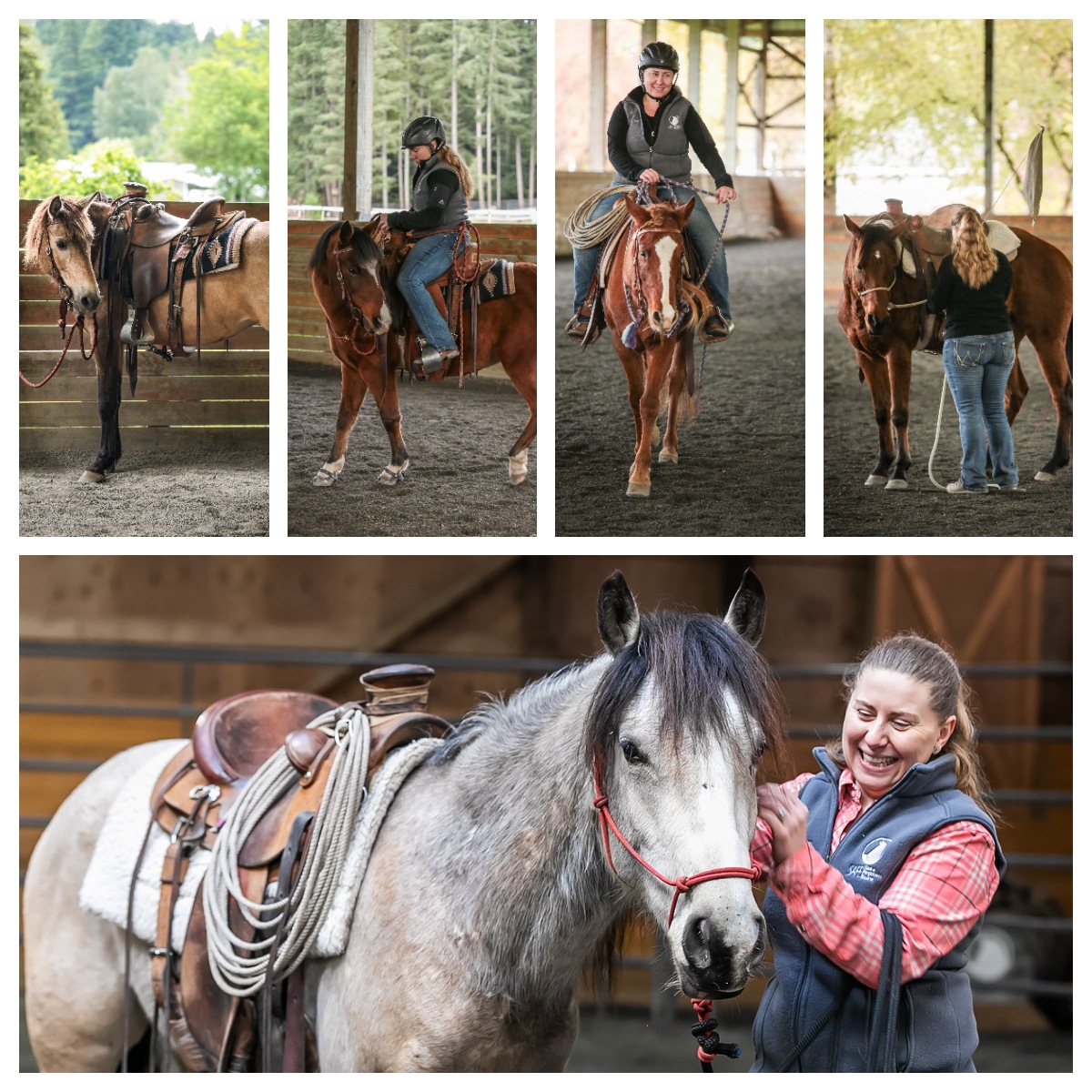
November Clinic Report: Frosting, Wren, Veronica, Artie, Esme
We finished off 2023’s training program horsemanship clinics on a high note. The incredible dedicated volunteers were like a well-oiled machine over the intensive five days. Wednesday and Thursday, we got our hands on 21 SAFE horses! From the barely haltered to those loping out on loose reins in the arena and some starting leg-yields and counter canter.
I had the pleasure of working 5 horses during the 3‑day clinic. I joyfully started every morning with a smile on my face and sweet nuzzles from our dear Frosting. This year she has been growing and for much of the summer was sadly in a very “ugly duckling” phase. I felt that she lacked the growth and physical maturity to really get on the “payroll”. I would pull her out a few times a month, dust off the groundwork and do a short ride. Each time she picked right off where I left her and felt good about letting her have time to grow.
This weekend she felt great! While I still think she needs time to fill out and muscle up into a riding horse, she felt ready to play with the big kids in class. We worked for about half of the class on building and keeping life, balance and freedom in her movement. She was a willing partner with a good expression and a ton more focus than we had earlier this year. I finished with her in the round pen with quick ride each day. The work we did in class helped these rides immensely. She had a good amount of life and checked off all the boxes quickly. She is going to be a nice pleasure horse for someone. She is a very willing, a kind hearted and well-behaved young mare.
For the second half of the morning ground work class, I took our recently started Wren. This special mare is hands down one of the nicer horses to come in this year and going to become a great riding partner. She has a ton of try and after working on freeing up her feet, she is becoming confident and relaxed. I can see the horse she will become and let me tell you, I like her! She will be sensitive and have a good amount of life as well as being a brave and willing partner.
I was very impressed with her changes throughout all 5 days of work. The last day Joel really helped her get her legs underneath herself and showed her how balanced and relaxed she could feel when she engaged her hind. He is remarkable with the horses and it was impressive to watch her transformation. After class I took her each day to the round pen for a short ride. We got some great changes and I could feel her each ride pick right up where we left off the day before. If she keeps this trajectory, she will likely become one of my favorite horses to ride at SAFE. It is said that the last horse you started is always your best and better than the ones before. I am grateful for all the horse that have taught me over the years. It is nice to see all the lessons they gave me, now helping Wren.
In the riding portion of class, I took in Veronica, Artie and Esme. I am literally jumping up and down with excitement for all three of these horses. Each one of them have come so far in the last year of riding.
Starting in June 2022 when Joel visited he would put a few rides on Veronica. I still remember feeling trepidatious when he handed me the reins in the fall and said she’s yours now. A lot of responsibility was transferred to me that day and with-it the stress to not mess her up! This week, I started calling her my war horse. SHE WAS SO BRAVE!! Anyone who has watched and followed her during her tenure at SAFE will agree, we were never 100% sure we could help gentle her, let alone if she was going to make it as a riding horse. She was up there as one of the hardest mares to come out of the Fall City Forty herd. There were many days that I thought she was going to come running through the panels and hurt herself. Her instinct to run away from anything and everyone was very strong. Today, she is one of the easiest horses for our volunteers to catch and lead. And in this clinic, her first riding experience with 14 other horses in the arena, she was a STAR.
The first day the wind and rain decided to not play nice. We had gusts of wind making roof insulation flap above our heads and leaves on the ground suddenly without warning flying towards us with. It would have been very acceptable for her to be nervous or jump, heck I even looked at the craziness around us and shook my head. She was a rock! I felt safe and confident that she was carrying me and that she trusted me, not only to keep her out of danger, but that we were a team. I love all of our horses, but I can say honestly, I really like the horse Veronica has become. I know that part of our success is the hours of relationship and trust we have built. I hope in the months to come to help her explore more of the riding world and introduce her to her future family. Joel said that he liked the freedom in her movement which is a great compliment for the tight and flighty mare we started last year.
Artie is done being called a slow poke! This clinic he showed us all that he has a GO button now! What a flashy pony he is becoming. We jumped into the riding class about half way through and he seamlessly fit right into the group. He was very punctual in his responses and his gaits started to open up. I asked Joel to help walk me through supporting him in backing circles to the right. This has been a sticky area and I wanted to make sure I was helping him correctly. Joel helped me work him through it by freed his feet up backing straight and timing up a release when he could hold the right flexion. Artie still has some rough spots like this where the wild man we took in shows up. I am very mindful how quickly things could go wrong if he didn’t have a confident rider. He can still get wide eyed at new things and takes an experienced rider to support him. But I know he is worth the effort! Just a year under saddle and feeling like he is path from here is bright. It is wonderful to see this once difficult stud turn into a gentleman gelding. He is making steady progress and really is a hoot to ride.
Lastly, I brought Esme out to work the last day of the clinic. She had two days off and as expected was a bit tight in the beginning but after some good ground work settled into the ride. After a year of riding, Esme is still very tight mare. She is like a little ball of energy and it has been a struggle to get her to fully relax and unwind. She has a very curious and has a genuine kindness about her but when in a bind she still feels trapped and become anxious. Out of all the horses I am working right now, she is the tightest. We get along but if something externally grabs her attention, she is not quick to relax. The biggest help has been on working on her feeling free to move which helps her letting down. When she relaxes, you can see her strides lengthen and her movement less balled up.
She isn’t the most troubled or difficult horse but I do have to manage the rides and support her to unwind. There is zero filling in for the rider and she would not give a young or novice rider any confidence. I was pleased that during our ride she was following my line nicely and finished comfortably at the end of the ride with a lovely walk, trot, lope and stop on a loose rein feeling of me. I trust that with the tools we have now she is going to make it. She will just take a bit longer to become the relaxed ride most adopters need. Hopefully with some good work put in this winter, others at SAFE can start riding her and she can maintain relaxation.
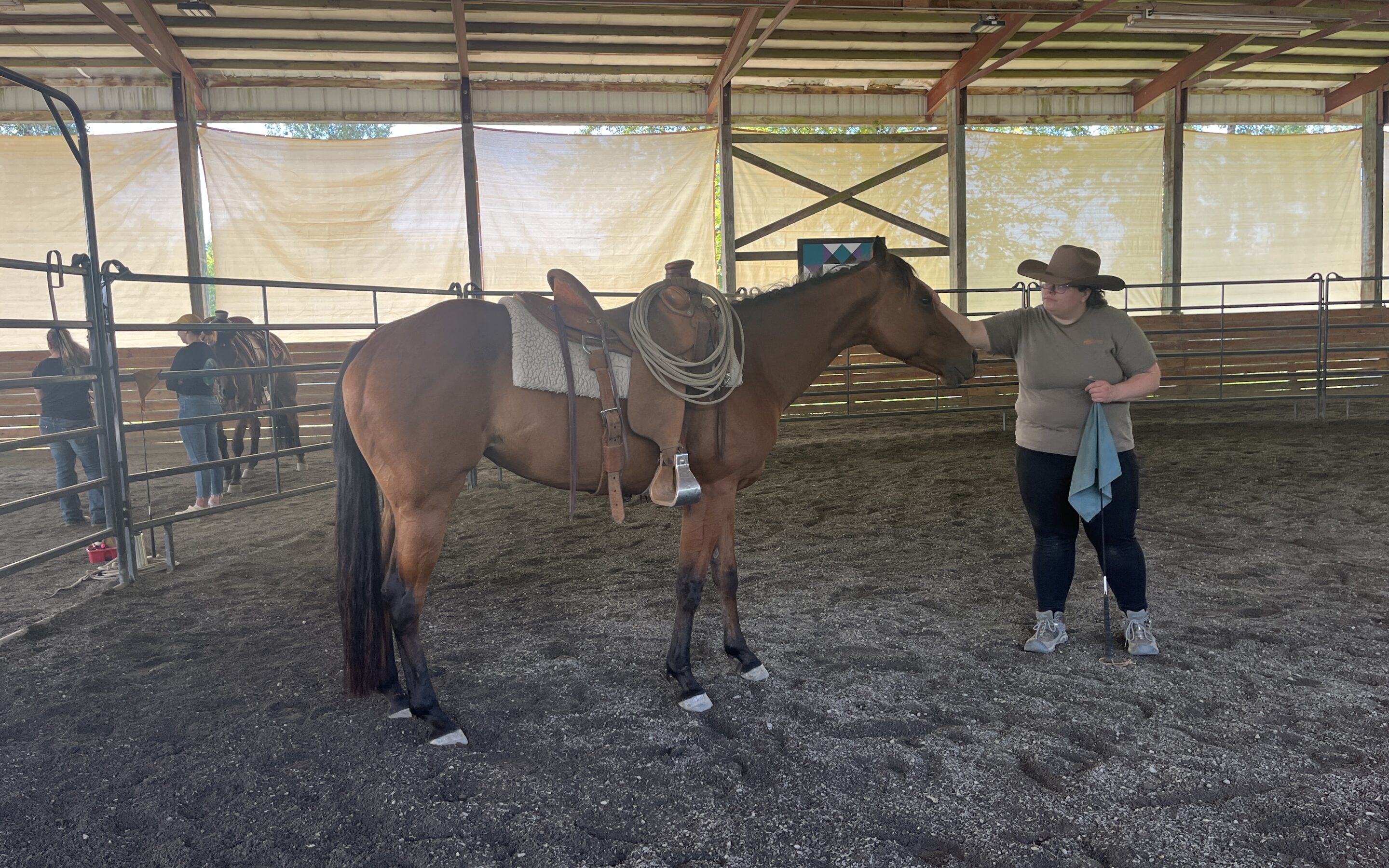
Wren’s First Saddle
For many of the horses who come to SAFE who are in need of a start or a restart, we spent a great deal of time preparing them for their first saddling and their first rides. But due to the variation in personalities and past histories, the speed at which we are able to hit these milestones varies.
Wren came to SAFE in May, and little was known about what had been done with her. From our initial assessment, it seemed like the answer was “not much.” This is the most ideal of scenarios, for it just means we have less muddy water to wade through on the way to clarifying our meanings.
In general, very little seemed to bother Wren. She was a very reasonable mind from the very beginning, and was the first of her group to do things like walk into the barn, spend some time in a stall, and leave the comfort of her paddock. Following that logic, it would only make sense that she would also be the first to wear a saddle. And while that’s not always how it works, in Wren’s case, it was.
Lexee N, who worked alongside Wren from the beginning, found her to be quickly progressing through their groundwork checklist, and quickly graduated her to throwing the pad and light synthetic saddle on her back. There was very little upset on Wren’s end — a sidelong glance initially, but perhaps not what you might expect for a horse with very little prior handling. Or at least, not the types who typically come through our program.
After a good bit of preparation involving groundwork, groundwork, and more groundwork, as well as plenty of tosses of the ‘real’ saddle to get her used to the heft and clank, we decided it was time to cinch her up. This was, like everything else, low-drama. She had no bucks, and really no trouble that made itself readily apparent. She was a little sticky moving forward, with a tendency to want to change direction without being asked, but when considering all the things that could (and often do!) happen when a horse is cinched up for the first time, Wren was about as easy as it gets.
We will not take this for granted, and while we appreciate when we get a horse like Wren who makes these steps so easy for us, we put her through the same paces as we do all the rest. It just happens that it is a bit faster with a mare like her. With the rate at which she is progressing, it seemingly wont be long until she is ready for an adopter! But no expectations — we will give Wren all the time she needs.
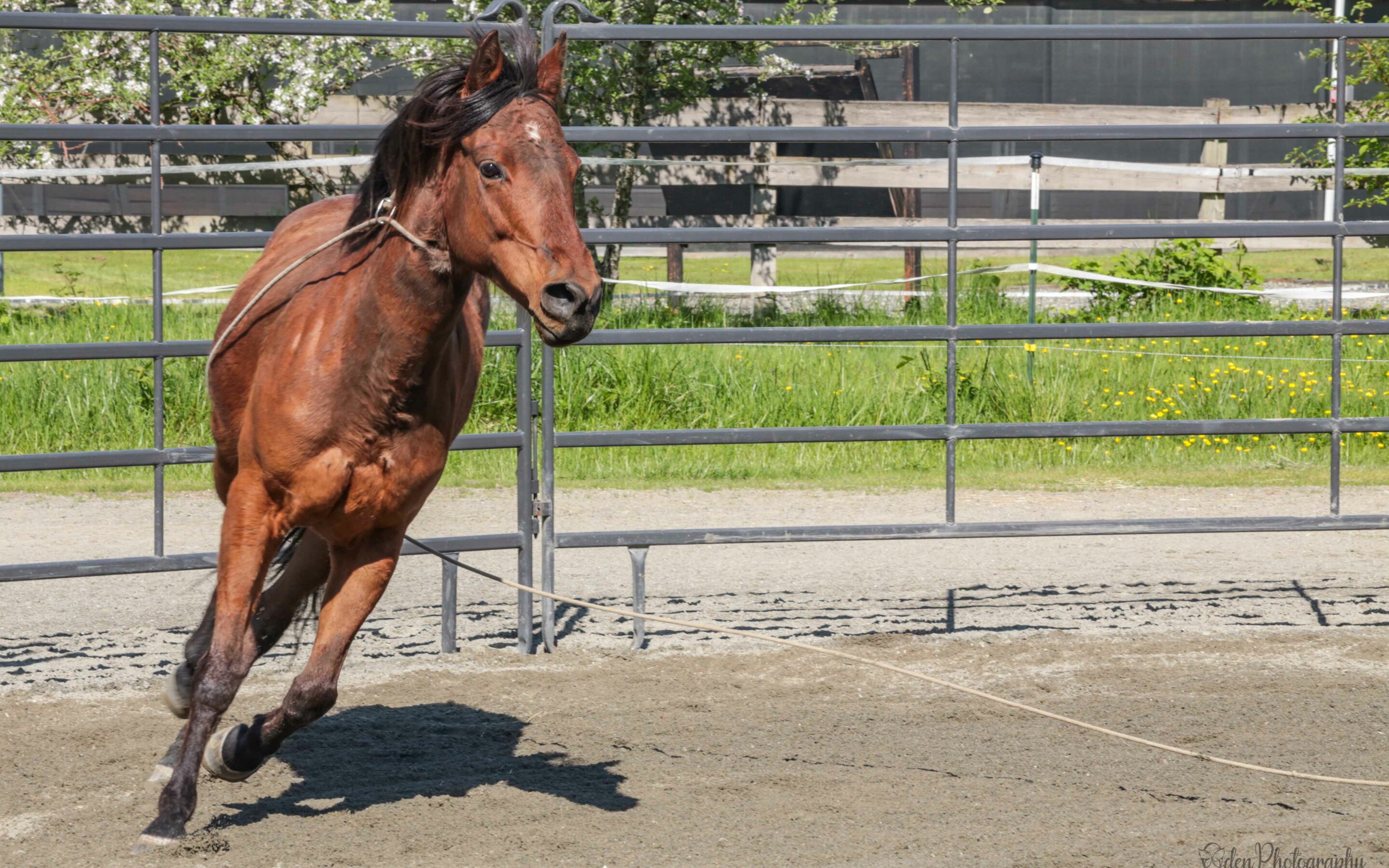
Introducing Wren
Wren came to SAFE back in May as part of a 7 horse rescue from the Gig Harbor area. She was living in a 4‑horse herd, and while initially curious, she was somewhat cautious around people at first, preferring to keep her distance.
But after her arrival here and those those initial days working with her, catching her with a rope in the round pen and beginning the halter starting process, Wren proved to be a very adept student. She was not, like some of her cohorts, unwilling to be pet, and was quickly able to be haltered after those first sessions.
Perhaps it was because she had not been “messed with” very much, but once in regular work, Wren had very little trouble with the introduction of new stimulus like the flag, and the rope. She was quick to learn how to pick up her feet, and stood very well for her first trim. She was the first of her herd to leave the nest, so to speak, and was able to participate in the groundwork portion of Joel’s July clinic outside of a round pen just a few weeks after her arrival.
We are so accustomed to horses coming through our program who have a lot to work through, that when we get a horse like Wren who has a better understanding than most, it almost feels like something is wrong. It should be more difficult, we think to ourselves, as she walks into the barn for the first time with hardly a squeak, or lets us start preparation for saddling only after a handful of sessions. But perhaps this is just what it’s like when starting colts who don’t come with a truckload of baggage. Regardless, when we get a horse like Wren, we do not take her willingness for granted.
And all this isn’t to say that Wren was going through the motions without any kind of challenge. There were still spots in there and things that she found difficult. It’s just that it took her a lot less time to come to an understanding of what was being asked of her, and we were more easily able to help her out of what trouble she did come across. She is a lovely mare, and we expect her to keep progressing through our training program at a good clip. Now that she has been removed from her previous situation, it will be quite exciting to see just what the future has in store for such a bright young lady!

Introducing the Gig Harbor 7
The majority of the horses who come to SAFE come as singles or in pairs. One here, one there, typically with some space in between arrivals. But on occasion, we are called to assist with a larger seizure. It hasn’t been all that long since the Fall City 40, and an even shorter period since we took in the Graham 27. Now, we were once again called to help with a multi-horse intake. Seven horses in the Gig Harbor area needed our help, the owner needing to quickly re-home horses that were not easily re-homeable. On the heels of the Graham horses, we felt a bit more prepared for a larger intake, but unlike the Graham horses, these horses had not had regular (or any) handling in some time.
So on a Saturday morning, we loaded up our trailers with panels, and set out with a robust team of people and a brigade of trailers and a plan to pull seven horses out of the mud.
Thanks to a ton of planning, a great deal of manpower, and an earlier scope of the property, we were able to successfully remove all the horses from the property over the course of just a few hours. We ran chutes from the pens, some quite winding and intricate, but everyone left unscathed, and arrived at SAFE in one piece.
Lancelot, the stallion, was the first to pull through the gates.
Next were mother and daughter, Ciara and Inula,
followed by the small herd of mares: Meadow and Mirana, the elders of the group, (and the only ones who allowed us to halter them), and Wren and Harissa.
Seeing them at SAFE was like seeing them with the lights clicked on for the first time. It was clear they were in need of some TLC, but out of the mud and muck, it became obvious just how much. Their feet were overgrown, slippered in some cases. The four mares had a line of what appeared to be rotten hair halfway up their legs, likely a result of standing in a high layer of wet ground. The mother and daughter stank, a smell like rotting, and while there was nothing visibly deceased on the property, it felt very much like a place where death lived. All of them, when confronted with clean water troughs, drank long and deep.
It was clear from the moment we set eyes on the horses that they would take some work to rehab and retrain. Even the mares who let us halter them were not keen on being touched much beyond that. We certainly had our work cut out for us. But this was not the first time that challenging horses had come through our gates, and it will not be the last. The road ahead might be long, but the most important thing is that these horses are safe now, and that is all that matters.

